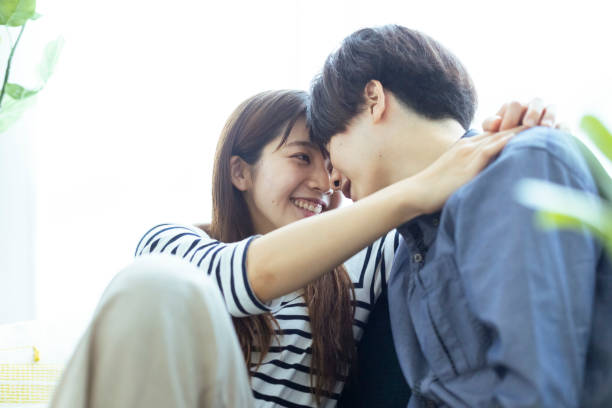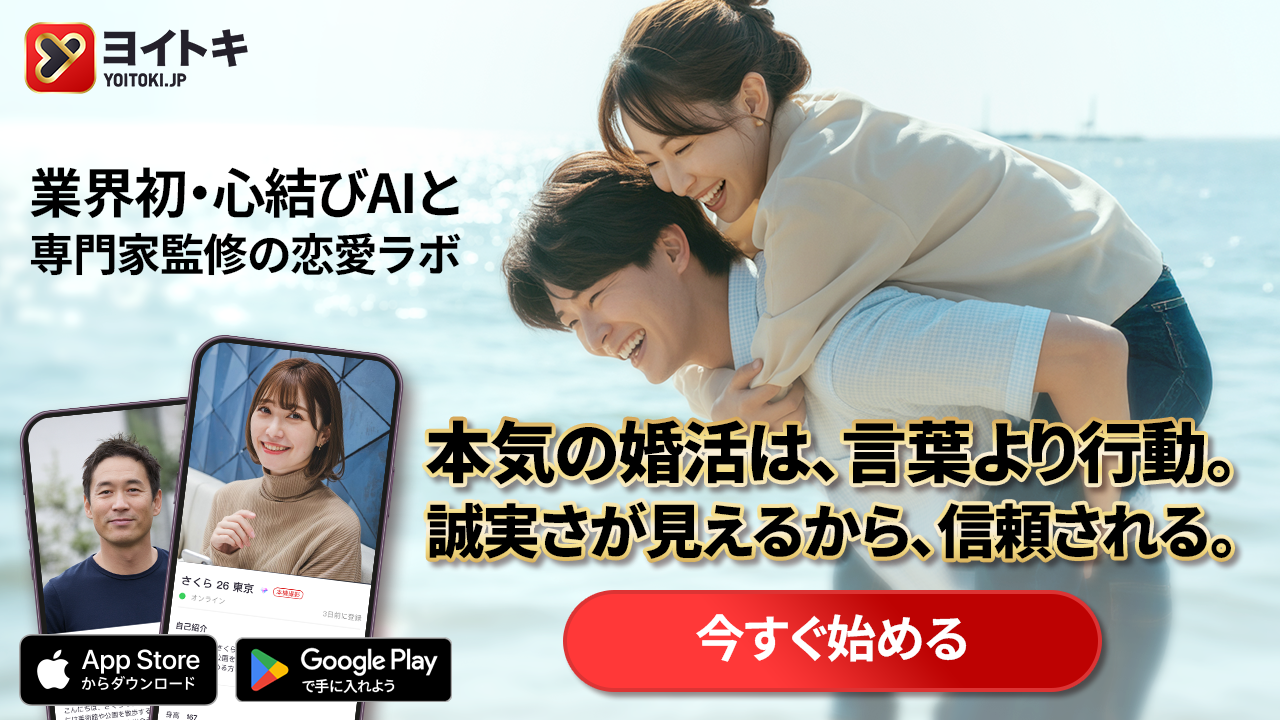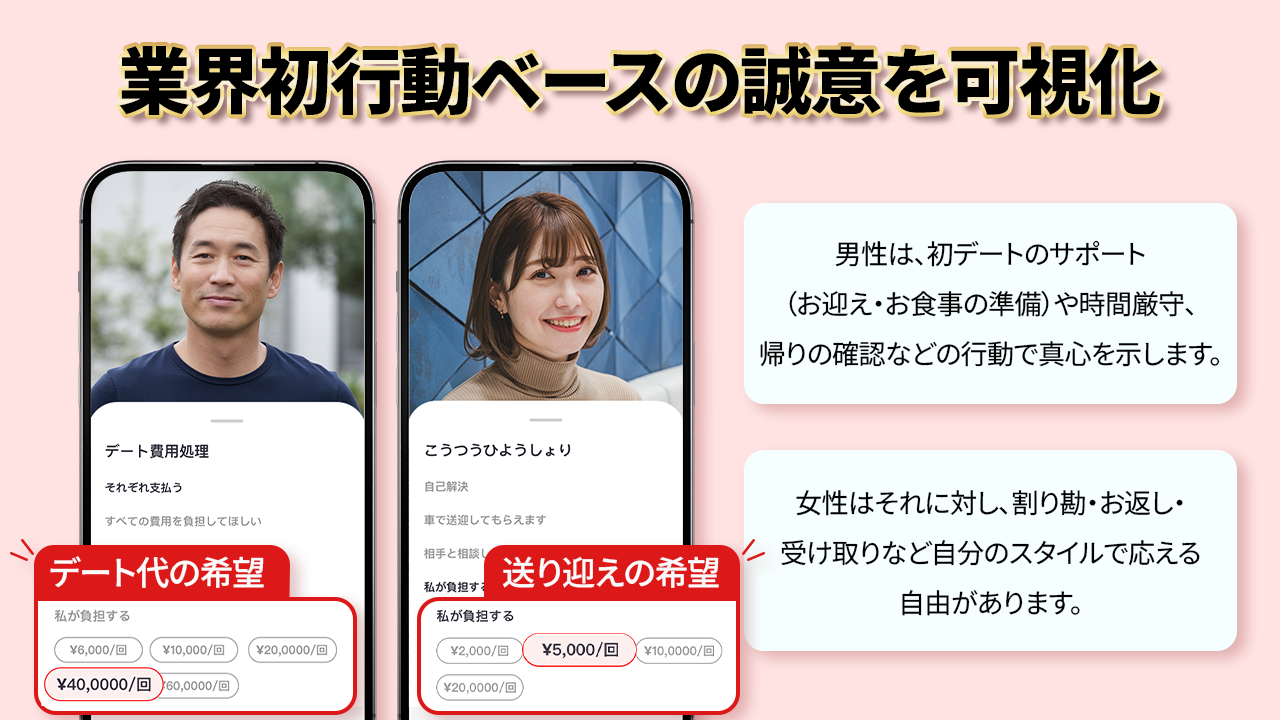“I wonder what that hug meant...”. That event, which occurred at the end of a date or in a fleeting moment, can sometimes produce great confusion and anxiety along with surprise. This is especially true when intentions are not yet clear to each other. The emotional turmoil brings about complex feelings as if one has stepped into unknown territory. The experience of being “hugged” serves as a trigger to explore each other's feelings.
Many dating advice pieces reduce the interpretation to a simple “hug = affection” or merely fit it into specific patterns. However, human relationships, especially those of adults with respect and compassion, are not that simple. One-sided interpretations can lead to misunderstandings or hurt feelings.
In this article, we will reframe the experience of being “hugged” as an opportunity to carefully reassess each other's feelings and relationships. From the perspectives of “mutual understanding” and “clear intentions,” which are valued by Yoitoki, we will organize your feelings and provide hints for considering the next steps together.
To Receive the True Message Beyond the “Types” of Hugs
The act of “hugging” carries diverse nuances depending on cultural and personal perceptions of distance. A survey has shown that the impressions people receive from hugs are greatly influenced by the context of the moment and the existing relationship with the other person. Before simply categorizing by “type,” let’s first take a step back and view the situation from the following perspectives.
Deciphering the “context” behind the action
Even the same “hug at parting” can have entirely different meanings depending on the situation.
- 【Example 1】As a conclusion to a fun date: If the entire date was filled with smiles and the conversation was lively, and if that hug happened naturally, resulting in a refreshing parting, it is likely to be an expression of affection and friendliness. It can be said that this was a moment when the “mutual effort” emphasized by Yoitoki bore fruit and brought you closer together.
- 【Example 2】As comfort or encouragement: If the hug occurred after you confided about a worry or showed signs of feeling down, this does not necessarily indicate romantic feelings, but often represents a display of empathy and support.
- 【Example 3】In the atmosphere or momentum of the moment: For example, a hug after a drinking party or during the exhilaration following a special event may be an act driven by the emotions of that moment. These may not have lasting significance.
In other words, rather than focusing solely on the single action of hugging, understanding the whole story in which it is embedded is the first step to receiving the true message.
Prioritize your “comfort” as the primary barometer
Before trying to gauge the other person's intentions, and even more importantly, it is essential to consider how you felt about that hug. This directly connects to one of Yoitoki’s core philosophies, “Emotional Equality”. Relationships are built not by “decoding” the other but through mutual “feeling and dialogue”.
- 【If you felt comfortable】: If you felt warmth, reassurance, and excitement, that is evidence that your heart is open to the other person. Even if the hug was not one of affection, the positive feelings you experienced are undeniable facts.
- 【If you felt discomfort or tension】: If you felt nervous because it was too sudden, or if you sensed that the distance had closed too quickly, or if you felt any kind of aversion, do not ignore those feelings. They may be signs that your personal space and boundaries are not being respected.
Your emotions serve as the starting point for all judgments and are the most reliable compass. Listening to this inner voice is the foundation for building an equal and healthy relationship.
To Build an Honest Relationship - How to Act and Tips for Dialogue After Being “Hugged”
The event of hugging defines the nature of the relationship based on how it is perceived and how one acts afterward. The advice here does not encourage games or manipulation, but is centered on honest communication. The “Clarity of Intent” proposed by Yoitoki is particularly put to the test at this phase.
Options for natural reactions that respect your boundaries
The smart responses you can make in the moment are ones that align with your true feelings. There is no need to force anything.
- 【If you have feelings and are happy】
- Receive it honestly with a smile, saying “Thank you, I’m happy.”
- Lightly hug back or take a small step towards the same direction (this is the ideal form of mutual effort).
- 【If you are confused or uncertain about feelings】
- Gently deflect with a natural smile and end the moment on a positive note. You might add something like, “Oh, I was surprised!”
- *It is also a valid choice to take time to organize your own feelings without forcing a response or delving deeper.
- 【If you feel clear discomfort or displeasure】
- Step back slightly and create physical distance. There's no need to force a smile.
- Express your feelings by saying, “I’m sorry, I was a bit surprised.”
Clarifying the relationship in the next communication
The next message or conversation after the hug is a great opportunity to advance the relationship. Let’s create the groundwork for positive conversations that leave no ambiguity.
- 【Positive Approach】: When you next reach out, say something like, “I had a great time on our date yesterday. Thank you,” affirming the whole date without directly mentioning the hug. Adding something like “I’d love to see you again” with clear intent will allow you to gauge the other person's true feelings from their response.
- 【Direct Approach】: If you are concerned, say, “I was a bit surprised by the hug earlier, but it was nice,” which conveys your impressions (I message). This allows the other person the opportunity to explain the meaning of their actions and opens a dialogue.
If necessary, convey your boundaries quietly but clearly
If you felt discomfort, the most important thing is not to blame the other person but to communicate your feelings.
- “Blame YOU message”: “Why did you suddenly hug me? It’s weird.” (← This will put the other person on the defensive and complicate dialogue.)
- “Convey I message”: “I’d like to take things a bit slower, so sudden physical contact is a bit...” (← This clearly communicates your boundaries and values without hostility.)
I messages are the basics of adult communication techniques that maintain integrity and dignity while asserting oneself.
💡 Yoitoki Insights: Beyond Algorithms
The challenges you face are exactly why we developed “Kokoromusubi”. While other apps match based on superficial traits, our AI discerns “deep compatibility” through how you handle stress, express compassion, and share values.
👉 Discover true compatibility with Yoitoki →
A Perspective to Discern Sustainable Connections, Not Fleeting Emotions
It’s natural to be elated or distressed by a singular event like a hug, but what truly matters is the sustainable relationship that follows. Yoitoki’s starting point lies in identifying the foundation for long-lasting partnerships rather than temporary chemical reactions or ambiguous signs.
Evaluate the “whole” relationship, not just the “single” hug
When assessing a person, it is essential to observe the consistency of their actions. A single act of hugging only has meaning within the context of their previous attitudes and behaviors.
- Everyday conversations: Do they listen to you and treat you with respect?
- Shared values: Is there a foundation for open discussions about what is important in life and future visions?
- Mutual respect: Do they respect your time, opinions, and boundaries? For example, consideration during dates (like a man showing concern for transport costs or meals) is a manifestation of respect and sincerity seen within the Yoitoki community. It is not an obligation but a testament to mutual effort in caring for one another.
Hugs symbolize deeper trust and intimacy only when these foundational relationship elements are solid.
The “Kokoromusubi AI” prioritizes “deep compatibility”
Yoitoki's AI matching system, “Kokoromusubi”, focuses not on superficial factors like education or income, nor on momentary “vibes”. Instead, it seeks to identify essential value alignments through profiles and conversations.
- How to handle stress
- Ways of expressing affection and compassion
- Life priorities (family, career, personal time, etc.)
- Communication styles
With such “Deep Compatibility”, the ambiguities that lead to overthinking a single hug significantly diminish from the start, allowing for a relationship built on “Emotional Equality”, where both parties respect and understand each other.
Frequently Asked Questions (FAQ)
Q: If I am hugged, is it always a sign of affection?
A: Unfortunately, it cannot be generalized. Various psychological factors such as friendship, comfort, or the momentum of the moment may be at play. At Yoitoki, we believe that the foundation of true affection lies in mutual understanding cultivated over time, not in isolated actions.
Q: How should I think if I am hugged by a married person?
A: In this situation, prioritize your own safety and dignity above all else. The risk of complicating relationships is high, and it may be extremely difficult to build a relationship with mutually sincere intentions. It is essential to maintain clear boundaries.
Q: How can I act naturally without feeling awkward when we meet next?
A: The important thing is to adopt an attitude that makes you feel comfortable. There’s no need to force the topic, but if you do, saying something like, “I was surprised back then,” can be one way to express your impressions. The other person's response will reflect their true feelings.
Q: If I have feelings, should I take the next step?
A: Please proceed at your own pace. What Yoitoki values is “mutual effort” where both parties move forward at the same pace. When you feel ready, taking actions with clear intent, such as casually inviting for another date, is the beginning of a healthy relationship.
Q: What does Yoitoki mean by “clarity of intent”?
A: It means sharing from the initial stages of profiles and conversations that both parties are seeking a serious relationship. This creates a foundation for open discussions about life views and values rather than superficial conversations. This helps reduce ambiguity around the “meaning of hugs” from the outset.
Conclusion
The experience of being “hugged” is indeed a moment that stirs the heart. However, it is not merely a puzzle to decipher the other person's feelings; it is also a precious opportunity to confront your own emotions and think about what kind of relationship you want to build together.
A truly rich relationship is not one that fluctuates with a single sign, but one that is built together through careful alignment of each other's feelings and values expressed in words and actions. In such a relationship, respect and reassurance abound instead of unnecessary suspicion and ambiguity.
Table of Contents
Shall we start a new form of meeting?
If you are tired of ambiguous relationships and seek a connection built on mutual effort and genuine understanding, your place is here.







